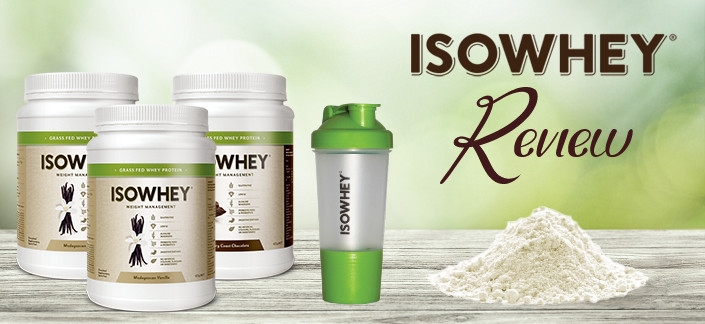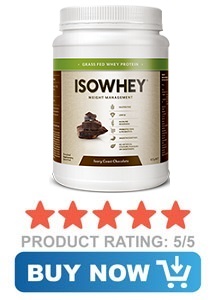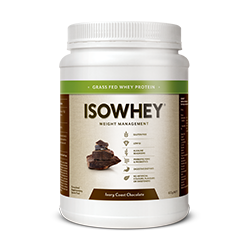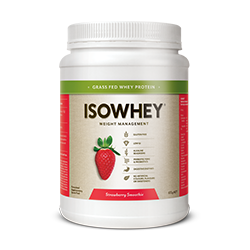Isowhey Review - Meal Replacement Reviews

Article Updated 9th March 2020
Isowhey is a powdered nutrition formula designed to target weight loss for the health conscious. This functional weight loss formula contains medium chain triglycerides (MCTs), probiotics, vitamins and minerals, all on a blend of premium quality whey protein.
Isowhey is sweetened with a natural polyol called xylitol, typically derived from the corn husk or birch tree, and offers a low 110 calories per serve, along with a high protein to carbohydrate ratio.
Who Owns Isowhey?
Isowhey is owned by Australian company Bioceuticals, a subsidiary of Blackmores Limited. Bioceuticals are national market leaders in practitioner-only products, supporting healthcare practitioners including doctors, naturopaths and osteopaths. Their formulations are evidence-based and always natural, produced in a state-of-the-art manufacturing facility.
Bioceuticals remain on the cutting edge of scientific and technological advancement, ensuring their products stay relevant to the needs of consumers.
Is Isowhey Gluten Free?
Yes, all of the ingredients in this meal replacement are gluten free.
Is Isowhey Lactose-Free?
Isowhey Weight Management contains 0.8 grams of lactose per serve. Most lactose-intolerant individuals can tolerate up to 12 grams of lactose daily.
 You might like to assess your individual lactose sensitivity yourself, which can be helpful when making dietary choices. It is also important to remember that your lactose sensitivity may change over time.
You might like to assess your individual lactose sensitivity yourself, which can be helpful when making dietary choices. It is also important to remember that your lactose sensitivity may change over time.
There is approximately 13 grams of lactose in 1 cup of full cream milk. If you can tolerate 20ml of full cream milk (providing 1.1 grams of lactose) taken twice daily, you should be fine with 1 serve of Isowhey taken twice daily mixed in milk-alternative, such as almond or soy milk, or cold water.
Is Isowhey a Complete Meal Replacement?
Yes, Isowhey Weight Management can replace 1 or 2 meals each day.
What’s the Difference between a Meal Replacement and a Protein Shake?
Protein shakes are formulated to deliver you only 1 nutrient: protein. Meal Replacement formulas, like Isowhey Weight Management, contain a range of nutrients, such as fibre, probiotics, medium chain triglycerides (MCTs), vitamins, minerals, carbohydrates and protein.
Protein shakes and meal replacement shakes are designed to be used differently. Protein shakes are often taken after exercise, between meals or to supplement a low protein meal. On the other hand, meal replacement shakes are typically consumed instead of a main meal.
Isowhey more closely matches the nutritional content of a meal than a regular protein powder. This means a quality meal replacement helps to prevent nutritional deficiencies that can develop when restricting food intake over time in order to lose weight.
Isowhey contains an appreciable amount of protein, essential for maintaining muscle mass and supporting general health.
Muscle Helps to Keep You Lean
It was no surprise back in 2014 when the American Journal of Clinical Nutrition published a research paper showing that meal replacements and high-protein diets supported the maintenance of weight loss.
It’s a standard rule that most people on weight loss programs lose quite a bit of muscle. This is not great for general health and it’s actually not helpful for keeping body fat levels down in the long term.
So why do we lose muscle mass on a fat-loss program?
When we reduce our food or calorie consumption our protein intake tends to drop as well. This is because protein is commonly found in fatty foods like cheese, whole eggs and full-fat meats, and even starchy foods as well, like bread and pasta.
So as calorie intake drops, so too does protein. And as protein intake drops, many of the anabolic signals that maintain our muscle mass become weaker.

Muscle mass does a lot more than just make us look athletic. Muscle helps with movement and supports coordination and balance. It also holds essential amino acids that are released when we are fasting for other parts of the body to use, much like a reservoir.
Even beyond these impressive roles, muscle keeps our metabolism firing. So if you can focus on retaining muscle mass whilst losing weight, when you finish the program your metabolism will be faster. You will also be at less risk of rebound weight gain.
Maintaining muscle mass can be as simple as incorporating some weight-bearing exercise into your exercise program each week, and keeping your protein intake topped up, with, let’s say something like an Isowhey Protein Powder.
Isowhey vs Optifast – What’s the Difference?
(Nutrient Comparisons Based on Chocolate Flavours)
Optifast is a very low calorie diet (VLCD) meal replacement shake owned by Nestle.
Calories
The chocolate flavour of Optifast contains 201 calories per 53 gram serve, compared to 109 Calories in each 32 gram with Isowhey.
Protein
Optifast delivers more protein per serve, at 20 grams, while Isowhey contains 15.2 grams in each serving. However, the protein sources are quite different. The protein in Optifast is derived from skim-milk powder, calcium caseinate and sodium caseinate.
Isowhey provide their protein from pure whey protein from grass-fed cows. Whey protein has the highest biological value of any protein due to its superior balance of essential amino acids and high content of leucine. A lower dose of quality whey protein is equivalent to a higher dose from other powdered protein sources.
Sugar and Lactose
Isowhey contains 1.5 grams of sugar per serve. 0.8 grams of this is lactose. Optifast delivers 9.5 grams of sugar in each serve, 9 grams of which are lactose. Isowhey is certainly a more lactose friendly meal replacement.
Fibre
The fibre content in each of these products is comparable, at 3.6 grams in Optifast and 3.1 grams in Isowhey (per serve). However, the source of the fibre does differ with each product.
Optifast derive their fibre from fructo-oligosaccharises and inulin, both of which are pre-biotics that support the growth of beneficial bacteria in the digestive system. Isowhey use the Litesse functional fibre in their meal replacement formula, which is highly soluble and swells in the stomach. This improves the feeling of fullness and reduces hunger.

Vitamins and Minerals
Each product is formulated in accordance with the food standards codes issued by Food Standards Australia New Zealand (FSANZ). There are upper limits sets in these codes that dictate how much of each vitamin and mineral can be put into a single serve.
Both Isowhey and Optifast contain comparable amounts of vitamins and minerals. While Optifast contains a little more of some nutrients, like potassium and iodine, Isowhey contains more of other nutrients, like magnesium and zinc.
Some of the nutrient forms used in Isowhey do offer better bioavailability. For instance, they use selenomethionine, chromium picolinate and potassium citrate to deliver selenium, chromium and potassium, respectively. These are regarded as some of the most effective supplemental forms of these nutrients.
Additives
Isowhey contains all natural flavours and sweeteners and is 100% GMO-free, while Optifast contains an unspecified flavour and the artificial sweeteners sucralose and acesulfame potassium.
 Conclusion
Conclusion
Isowhey is a fantastic product that can be used to assist with weight loss and weight management. Because it is a formulated meal replacement, you can substitute 1 or 2 meals per day with this product.
We found the flavours to be nice and not too overpowering. There are a range of recipes on the Isowhey home page that work really well with the Isowhey powder.
We rate this product exceptionally high due to the palatability, quality of ingredients and exclusion of artificial chemicals. This is a weight loss formula for the health conscious who want to lose weight and keep it off.
References
Header Image Background Created by Rawpixel.com, Courtesy of FreePik.









